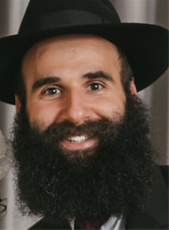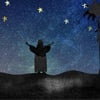22 Facts About Hebron Every Jew Should Know
1. Hebron Is One of the Four Holy Cities of Israel

A 19th-century depiction of the Four Holy Cities of Israel. (Photo: Wikimedia)
Israel has four holy cities: Jerusalem, Tiberias, Safed and Hebron. Hebron is the only one where Jewish people currently comprise but a small portion of the population, yet it holds a special place in the hearts of the Jewish people.
2. Abraham Lived in Hebron

The refurbished interior of the Avraham Avinu synagogue in Hebron. (Photo: Wikimedia)
Hebron is first mentioned in the Bible as the place where Abraham built an altar to serve G‑d, after G‑d told him to “arise, walk in the land [of Canaan], to its length and to its breadth, for I will give it to you.”1 The place where he settled is described as the “plain of Mamre, which is in Hebron.” Mamre is credited with encouraging Abraham to follow G‑d’s advice to circumcise himself and his household.2
3. It Is Often Called Kiryat Arba

The local council of the Kiryat Arba community, just outside historic Hebron. (Photo: Wikimedia)
In many instances Scripture specifies that Hebron’s older name is Kiryat Arba (“the city of four”). Rashi cites a Midrashic tradition that it was thus named because of the four giants who lived there: Ahiman, Sheshai, Talmai, and their father. Another explanation is that it is thus named because of the four couples who were buried there: Adam and Eve, Abraham and Sarah, Isaac and Rebecca, Jacob and Leah.3 Contemporary Kiryat Arba is a Jewish town east of Hebron, founded in 1968.
4. Abraham Purchased It

After his wife Sarah passed away at the age of 127, Abraham came to Hebron to mourn and bury her there. The Hittites who lived there at the time offered Abraham the spot of his choosing, and he chose a cave in the field of Ephron. Ephron offered it to Abraham as a gift, but Abraham insisted on paying fair and square, ultimately purchasing it for 400 shekels of silver. This is the first recorded Jewish purchase of land in Israel.
5. Adam and Eve Were Buried There First

The cave held significance even before Abraham purchased it. After Adam was banished from the Garden of Eden, G‑d Himself prepared a place near the entrance to the Garden, hewed out of rock, where he would bury Adam, the patriarchs and the matriarchs.4 The cave belonged to Ephron, but only Abraham was spiritually sensitive enough to know of its significance.
6. (Almost) All the Patriarchs and Matriarchs Were Buried There

A menorah proudly displayed on a hill in Hebron. (Photo: Wikimedia)
No matter where they passed away, all three patriarchs—Abraham, Isaac and Jacob—were buried together with their wives in Ephron’s cave, which became known as Me’arat HaMachpelah, “the double cave.” Of Jacob’s two wives, only his wife Leah was buried there. Rachel, his favorite, was interred on the roadside on the way to Bethlehem. Alone and forlorn, tradition tells us, Rachel prays for her children and elicits the Divine promise of her children’s return to their Promised Land.
7. Jacob Lived in Hebron

"The Hill of Hebron From the Southeast." (Photo: Wikimedia)
In Scripture’s rendition of the story of Joseph and his brothers, we are told that Jacob dispatched Joseph “from the valley of Hebron”5 to seek his brothers, who were out tending sheep.
8. The Spies Came to Hebron

An Israeli stamp from 1955 shows the spies carrying a cluster of grapes picked from the Hebron area. (Photo: Wikimedia)
9. Hebron Was a Sanctuary City

Hebron was one of the cities dedicated as an ir miklat, “city of refuge.”8 Thus the priests, who were not given a portion in the land, were invited to live there. Moreover, a person who had accidentally killed another could live there safely, protected from the victim’s vengeful relatives.
10. It Was David’s Capital Before Jerusalem
![A seal dating back to the First Temple period, inscribed with the words "lamelech [to the king] Hebron." (Photo: Wikimedia)](https://w3.chabad.org/media/images/1067/dtGE10679406.jpg?_i=_n504BC99DD0473598AAE3BCDC5D75568D)
A seal dating back to the First Temple period, inscribed with the words "lamelech [to the king] Hebron." (Photo: Wikimedia)
Hebron appears to have been a major political, social and spiritual center in the era of King David. Before David ruled in Jerusalem, Hebron was the seat of his monarchy for seven and a half years.9 Years later, it was there that his son Absalom started his rebellion.
11. The Best Lambs Were From Hebron

Animal sacrifices were brought on a regular basis in the Holy Temple in Jerusalem. The Talmud reports that in an effort to secure the very best lambs for sacrifices, they would purchase lambs that had been raised in the healthy hills of Hebron.10
12. Judah the Maccabee Captured It

An artist's rendition of Judah the Maccabee in battle. (Photo: Wikimedia)
During the Second Temple period, Hebron appears to have been a fortified city ruled by Edomites. Thus, when Judah the Maccabee recaptured gentile footholds in the Holy Land, we are told that he attacked Hebron and its suburbs, destroyed its fortifications and burned the towers around it.11
13. Herod Built a Magnificent Structure There

The Cave of the Patriarchs compound as it appears today. (Photo: Wikimedia)
Herod, a king of Judea best remembered for his cruelty and for the grand buildings he commissioned, had a magnificent rectangular enclosure built around the site of the Cave of the Patriarchs. With sturdy six-foot-thick walls, this structure is part of the complex that still stands today. Look closely, and you will notice that the stones resemble those of the Kotel, which was also built under Herod’s rule.
14. Jews Lived There For Much of the Exile

Image of Maimonides (Wikimedia)
Even after the Romans ransacked Judea and exiled the Jews, Jewish people continued to live in Hebron whenever possible. During the Crusader period the Jews were expelled from Hebron, but later, certain Muslim rulers permitted them to live there. Even under the crusaders, Jews made the effort to visit Hebron and pray at the burial site of the patriarchs. Both Maimonides and Benjamin of Tudela recorded how they visited and prayed there in the mid-12th century.
15. Spanish Exiles Settled In Hebron

Avraham Avinu synagogue, built by Sephardic Jews in Hebron, as it appeared circa 1925. (Photo: Wikimedia)
Following the Spanish expulsion of all Jews who refused to convert to Christianity, a contingent of Spanish exiles came to Hebron. Led by Rabbi Malkiel Ashkenazi, they built the Avraham Avinu Synagogue in 1540. Centuries later the second Chabad rebbe, Rabbi DovBer, purchased a synagogue in the lower level of the structure, now the oldest Chabad synagogue in the world.
16. Chabad Chassidim Settled in Hebron in 1815

Beit Schneerson. (Photo: Dr. Avishai Teicher)
The Ashkenazic community in Hebron was founded by a group of Chabad chassidim in the early 19th century. For decades they were led by Rebbetzin Menuchah Rachel Slonim (daughter of Rabbi DovBer) and her husband, Rabbi Yaakov Kuli Slonim. Jews and Arabs alike sought her advice and blessings. Known as Beit Schneerson, her house has been renovated and is now home to several Jewish families.
17. Sephardim and Ashkenazim Lived Side By Side

Rabbi Chaim Chizkiyah Medini in Crimea, where he led the community for decades before moving to Hebron. His wife, Rivkah, is to his right. (Photo: Wikimedia)
Hebron was home to prominent Ashkenazic and Sephardic communities. Rabbi Chaim Rachamim Yosef Franco, the Rhodes-born leader of the Sephardic community, founded the Chesed LeAvraham Hospital, which served Jews and Arabs alike, in 1893. Since 1909 it has been known as Beit Hadassah, after the Hadassah Women’s Zionist Organization of America took responsibility for the medical staff. After the rabbi’s passing, the Sephardic community was led by Rabbi Chaim Chizkiyah Medini, known for his encyclopedia of Jewish law, Sdei Chemed.
18. Great Yeshivot Have Their Roots in Hebron

Beit Romano housed the Yeshivat Torat Emet. Today, greatly enlarged, it is once again a yeshivah.
In 1911, Rabbi Sholom DovBer of Lubavitch dispatched some of his most accomplished students to Hebron to establish Yeshivat Torat Emet. This endeavor was cut short, however, by the outbreak of World War I. Since Turkey (which then ruled the Holy Land) sided with the Germans, many of the students, who were Russian citizens, were forced to leave. The yeshivah was eventually relocated to Jerusalem, where it is still a center of Torah scholarship.
In 1924 a branch of the famed Slabodka Yeshivah was founded in Hebron. This yeshivah flourished until Jewish life there was cut short by the 1929 Hebron Massacre. It too relocated to Jerusalem, where it has grown exponentially, and is still known colloquially as the Hebron Yeshivah.
19. 67 Jews Were Murdered in the 1929 Hebron Massacre

The Avraham Avinu synagogue desecrated during the Hebron riots in 1929. (Photo: Wikimedia)
Jewish community life in Hebron was curtailed in the summer of 1929 following a violent pogrom that included rioting, pillage, rape and murder by Hebron’s Muslim residents. Among the victims were toddlers, women, yeshivah students and the elderly—including members of the Slonim family, who were well known by Muslims as well as Jews. The city’s remaining Jews were evacuated by the British. Following the 1948 War of Independence, Hebron fell under Jordanian rule, and no Jews lived there until after the 1967 Six-Day War.
20. Jewish Life Resumed in Hebron After the Six-Day War

A new Torah scroll is welcomed to Hebron with singing and dancing. (Photo: The Hebron Archive)
Following the miraculous victory in the Six-Day War, excitement grew around the prospect of renewing Jewish life in Hebron. In time, Kiryat Arba grew and Jews settled in the center of Hebron itself, reclaiming Jewish properties and restoring them to their former glory. The Avraham Avinu Synagogue, Beit Hadassah and other Jewish facilities are once again bustling, the voice of Torah study and prayer heard among their stone walls.
21. Hebron Is a Divided City

A memorial to ten-month-old Shalhevet Pass, who was killed in her stroller by a sniper on March 26, 2001, in Hebron.
Following the 1995 Oslo Agreement and the subsequent 1997 Hebron Agreement, the city was divided between Israel and the Palestinian Authority. The majority of the city (H1) is controlled by the Palestinians, and the remainder (H2) is under Jewish rule.
Yet despite the challenges, Jews continue to flock to Hebron, “the city of the fathers.” Every year on Shabbat Chayei Sarah, when Jews all over read the story of Abraham purchasing a plot in Hebron for 400 shekels, visitors pour in for a festive and spiritually uplifting Shabbat experience.
22. Jewish Prayers Ascend Through Hebron

Praying the afternoon service while visiting Hebron. (Photo: The Hebron Archive)
Despite the difficulty (and danger), Jews continue to stream to Hebron to pray. It is generally said that all prayers ascend to heaven through the Temple Mount in Jerusalem, the former site of the Holy Temple. Yet there is an ancient tradition that our prayers (first) go to Hebron on their path to G‑d.12
FOOTNOTES
1.
Genesis 13:17–18.
2.
At times Scripture refers to it as Eshkol as well, after a brother of Mamre (see Bereishit Rabbah 58:4).
3.
Rashi, Genesis 23:2.
4.
Zohar Chadash, Ruth; Zohar 1:127–128.
5.
Genesis 37:14. Note that Rashi ad loc implies that Scripture may not be describing Jacob’s literal geographic location in this instance.
6.
Rashi, Numbers 13:22.
10.
Talmud, Menachot 87a.
11.
I Maccabees 5:65.
12.
Cited by Rabbi DovBer, the second rebbe of Chabad and founder of the Chabad community in Hebron.




No comments:
Post a Comment